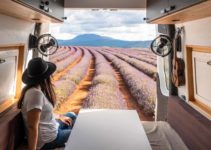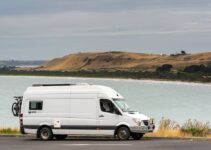Planning the best campervan water system is important. Learn the best practices for planning your van’s plumbing system.
Having an efficient campervan water system is the difference between merely traveling around in a van and camping, versus calling it van life. The idea of van life entails being comfortable while you travel, having many of your home comforts with you along the way.
One of these van life comforts, which we take for granted back home, is water supply and basic plumbing. We don’t tend to think twice about these things and life without them. But when on the road, having a functional campervan water system is essential.
Imagine not being able to take a shower, or wash your dishes or clothes after using them. These are essential for maintaining a clean environment for yourself and your travel companion.
A campervan plumbing system will allow you to have a running water supply that is both cold and hot for drinking, general washing up and even a shower. A properly designed system will also take care of both grey water and black water.
While some might see a campervan water system as a luxury, we feel that it is an essential addition to any van conversion. This is especially relevant if you’re going to be spending large amounts of time traveling and away from home comforts.
In this guide, we will look at suggestions and explore a comprehensive campervan water system as well as the plumbing and fittings that go along with it. We will also look at how to manage grey and black water within your van and everything else in between.
Let’s dive in!
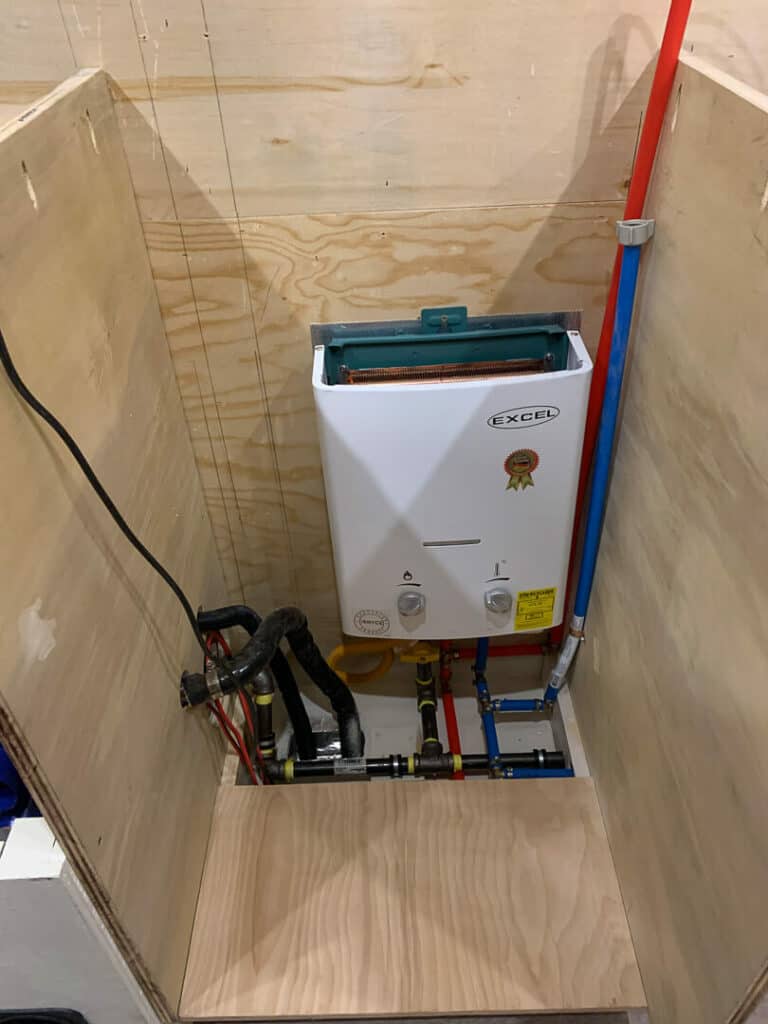
Campervan Water Systems – Understanding Van Plumbing
A cleverly designed campervan plumbing system will allow you to experience the comfort and convenience of home life, providing you with cold and hot water for your camper van. This complete camper van water system will enable you to wash your dishes and clothes on the move and even have a nice hot shower after a long day of driving or exploring.
This will be made possible through the installation of a number of different campervan plumbing components, cold water supply pipes, hot water flow pipes, and of course, an effective wastewater management system to complete it.
Fresh Water Tank
A fresh water tank is where it all starts – it is where you will be storing water when on the move. It is also one of the most important components of the blue water system.
The blue water system is essentially the fresh water supply system for your van. It will provide you with clean water for drinking, showering, washing clothes, cooking, and the dreaded cleaning up afterward.
An important factor to note is that, because you will be using this water for cooking and consumption, you should always use materials that are food-safe for its construction. This means all pipes and other components.
There are a couple of important considerations to bear in mind when looking at freshwater tank options:
size
The water capacity of your freshwater tank should be based on your water requirements. This will be affected by the number of people in your van and the basic daily water needs of each.
This is the total amount of water that you would expect to use on a daily basis for all activities from drinking all the way through to showering.
The size also affects the balance of your van as, when full, a water tank is a significant additional weight to carry. You will need to consider the weight distribution of your freshwater tank as 16 ounces of water weighs 1 pound. So it is important to consider this when placing your water tank in your van.
Storage is also another factor to consider – where will it go?
durability
You want to buy a water storage tank that is durable. Period. The last thing you want is for your water storage tank to leak inside your van. It could cause mold and rot and also destroy all your electrics within.
Remember, the bumps in the road and the off-roading will affect your water tank.
Now, there are a couple of different options when it comes to fresh water tanks – they can either be permanent or portable. Each has its advantages and disadvantages, which we will look at below.
Permanent
As the name suggests, a permanent fresh water tank is either fixed inside or outside of your van and it can’t be moved around. It can also be strategically located inside your van, concealed by a cupboard, under the bed, or even stored underneath your van.
They also offer the most storage space for water, which is always a good thing when on the road less traveled. Fresh water supply can be an issue so rather be sure to have your own supply.
Like everything in life, there are pros and cons to every choice. Let’s look at them for the permanent fresh water tank.
Pros
- It has the highest water storage capacity
- Installed by a professional, so the work is guaranteed
- More durable materials used to manufacture them
- Many different options available to suit your needs and the configuration of your van
- Can be installed outside your van in order to save space
Cons
- More expensive than portable tanks
- Can be potentially difficult to repair and clean depending on the location
- Installation can be expensive
- Extremely heavy when full which can affect your van’s performance and gas consumption
- You may have to make significant modifications to your van to accommodate it
Portable
A portable fresh water tank on the other hand, can be moved around and isn’t fixed to your van, although securing it is important. This will prevent it from flying around and damaging other appliances or injuring you.
They are easy to move around and are generally inexpensive so can save your money on your van conversion, especially if you’re on a tight budget.
Again, let’s explore the pros and cons of the portable fresh tank tank.
Pros
- Cleaning is easy as you can move it around
- They aren’t very expensive compared to the permanent tanks
- They’re easy to fill up as you can simply pick them up to reach the filling point
- It’s easy to tell how full they are without the need for a level gauge
Cons
- The storage capacity is small compared to permanent tanks
- Will generally be stored inside, taking up space
- They become heavy when full so transporting can be a mission
- Is a great short-term solution but not practical for long-term travel stints
Read More: Check out our buyer’s guide to learn more about and make the best purchase decision for your campervan tanks.
Wastewater
It is important to note that with every bit of clean water you use, there is going to dirty water that remains. This can be from doing dishes, taking a shower, or flushing a toilet. This wastewater can be divided into two categories – grey water and black water.
It is crucial that you have systems in place inside your van to be able to manage and take care of this wastewater. Having the correct black and grey water system installed is of the utmost importance if you are going to have plumbing, appliances, and an entire water system within your van.
Once you have captured this wastewater in black and grey water tanks, it is again crucial for you to be able to access it easily in order to dispose of it.
Grey Water Tank
Grey water is any form of wastewater that develops as a result of taking a shower or doing the dishes. In other words, this water has not come into contact with either urine or feces.
If you don’t plan on showering or washing dishes inside your van, then you won’t need to install a grey water tank. But if you do intend on doing so, then you will need to install a grey water tank that can store this waste water until you can dispose of it.
This can either be in a permanent tank or a portable tank.
Permanent
A permanent greywater tank can be installed either inside or outside your van. If you prefer the tank inside, you can place it out of sight under the sink, under the van floor, in a cupboard, or behind the driver’s seat.
It is recommended that it be inside during the winter as the waste water inside can freeze.
The permanent grey water tank should also be in a spot that is easily accessible as you will need to empty it when it fills up.
Portable
A portable grey water tank on the other hand is a lot easier to take care of. You can simply remove it when it fills up and empty it when it is convenient to do so.
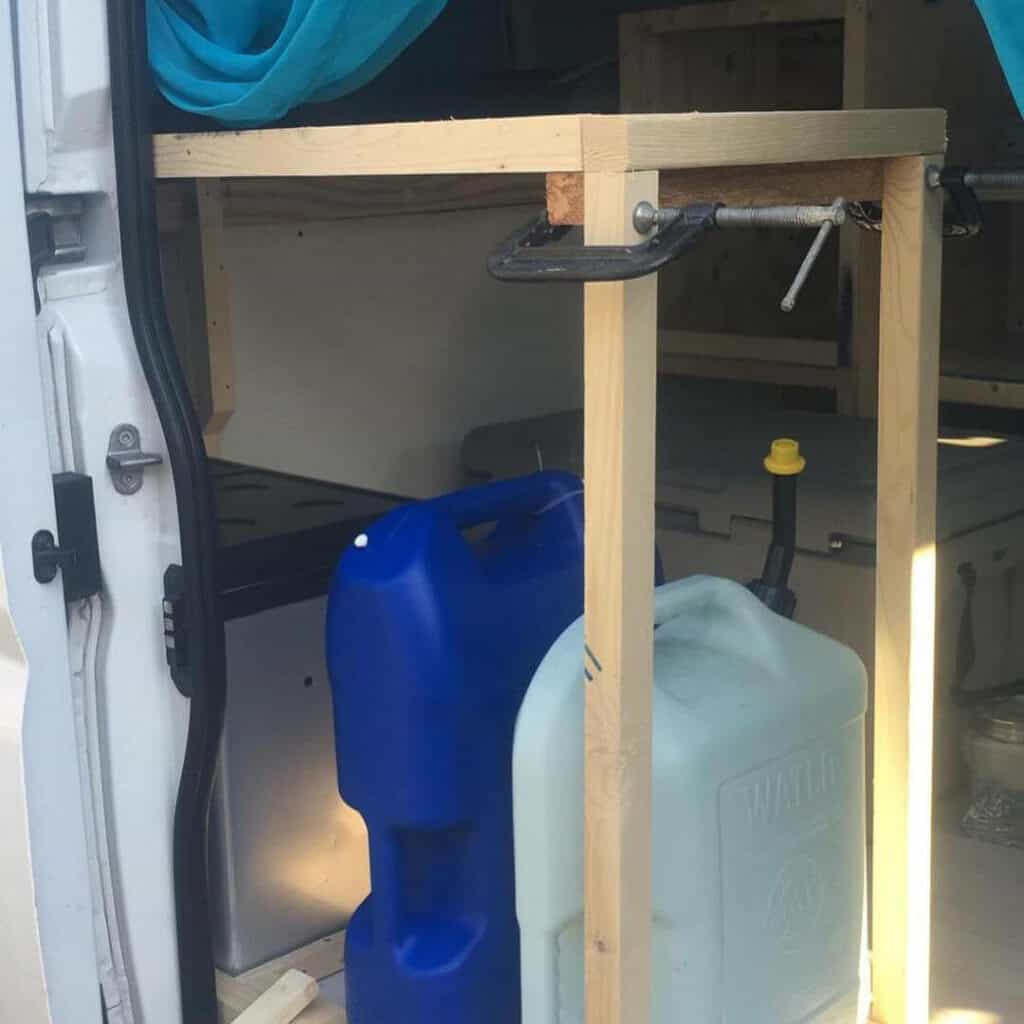
Black Water Tank
A black water tank is responsible for housing all matter that is collected in your toilet, whether it be urine of feces. After you flush your toilet, black water is collected in this tank, to be stored and disposed of when full or convenient to do so. Hopefully the latter, in this case.
However, there is the option to purchase a toilet that has its own composting mechanism built it. This removes the need to have a black waste water tank within your van.
This is a far better option as it removes the inconvenience of having to search for RV dump stations. The toilet is also completely separate from the rest of the van’s water system, which simplifies your setup somewhat and also eliminates the need for black water waste pipes.
A great option for a composting toilet is the Nature’s Head Self-Contained Composting Toilet. We love the one we have and think it’s a great alternative to finding public restrooms.
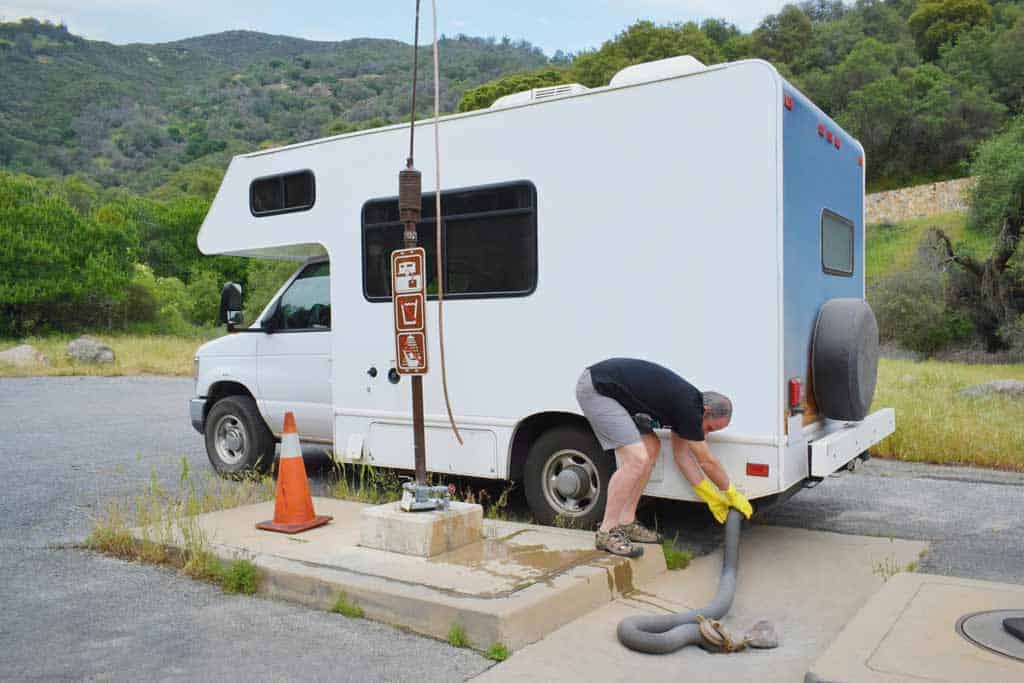
Related: Read our review and recommendations about Nature’s Head Composting Toilet.
Water Pump
Once you have a fresh water storage tank in your van, the next important consideration comes in – how are you going to move the water around?
This can be done by means of a water pump. It is one of the most important aspects of the campervan water system. The water pump will move clean drinking water throughout your van from water tanks all the way to appliances.
There are a couple different options available for moving water around your van. Let’s explore them below.
Electric pump
An electric pump is by far the most convenient. It is responsible for pumping water to both the shower and the sink, as well as the toilet (if you require a water supply to it).
The easiest option is to use a submersible water pump. This will be, as the name suggests, submersed into your water storage tank to supply water throughout your camper van.
It requires a 12v power supply so it can be run off your van’s battery or its own separate power supply. An external isolator switch allows you to turn the pump on and off.
They are simple to install and generally don’t require a professional to do so which saves cash when it comes to your van conversion and installation.
Another option for an electric pump is a pressure-sensitive water pump. They are the most efficient pump but are costly to install and maintain.
Manual pump
The second option is a manual water pump. This is the simplest way to move water around your camper van and it doesn’t require a power source – just a bit of elbow grease.
You simply pump and water flows. They’re also quiet and reliable, making them highly recommended.
Read Next: Be sure to check out our buyer’s guide for campervan water pumps.
Sink/Faucet
Having a sink in your van is imperative. You can prepare food and vegetables in it and also wash your dishes and hands. It doesn’t have be complicated and any sink will do. The only issue is that counter space is limited in a van.
A great option for a sink is the Dometic counter sink. It has a faucet, sink drain, and even gas top for cooking – a one-stop shop. It’s also compact and foldable making it a camper van essential.
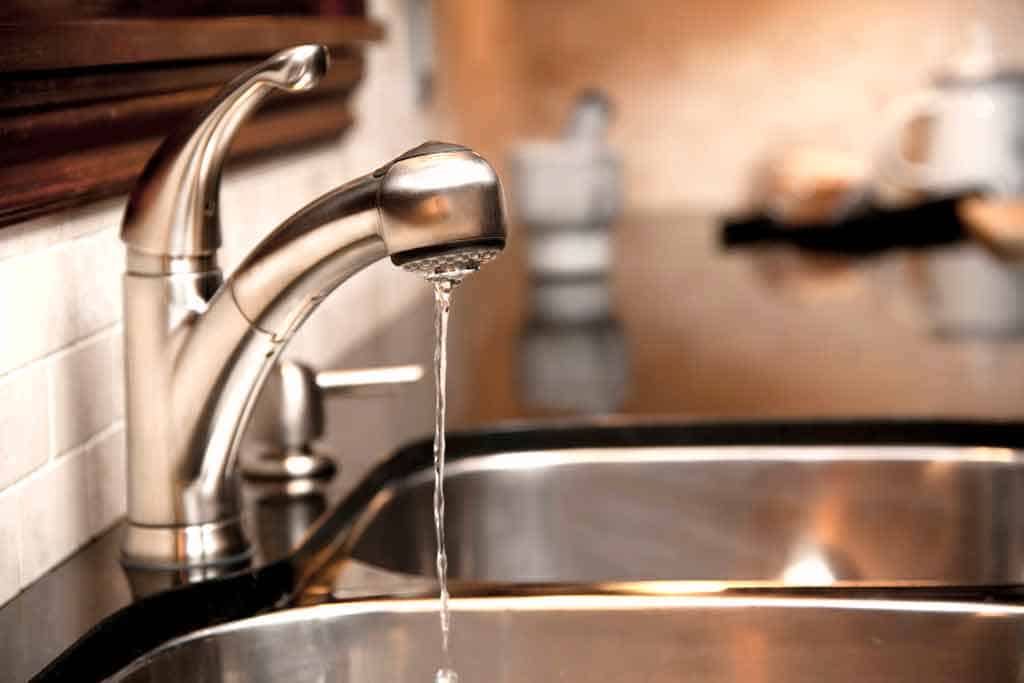
Plumbing a sink
A sink requires a water source coming into it from the campervan water tanks, which can simply be cold, but you can also ensure there is a hot water supply from water heaters.
The water pump will draw water from the tank and ensure you have water available constantly to supply the sink tap. Finally, you will require a wastewater collection tank as part of your grey water system.
Read Next: Our review of the best camper van sinks will help you make the best buying decisions for your van.
Shower
Having a shower is one of those home comforts I spoke about in the beginning. It’s the difference between simply camping and van life. After all, who doesn’t love a hot shower after a full day of driving or exploring?
There are different options for a shower for your camper van – it can either be inside or outside of your van and cold water only, or with hot water too.
indoor shower
An indoor shower is by far the best option, but is also the most complicated to install. You will require water to the shower, whether cold or heated, some form of extraction as to prevent condensation, and drainage to a grey water storage tank.
A propane water heater is an option to go for that will heat your water on demand. This means hot water at your fingertip, always. Alternatively, in the summer, you can have a black PVC water tube mounted to the roof of your van to heat up water naturally as you drive.
outdoor shower
An outdoor shower is by far the easiest option. The grey water can simply drain directly to the outside and you can rely on the sun’s rays to heat water. They are also the cheapest option, with a built-in shower head, so all around, a big win.
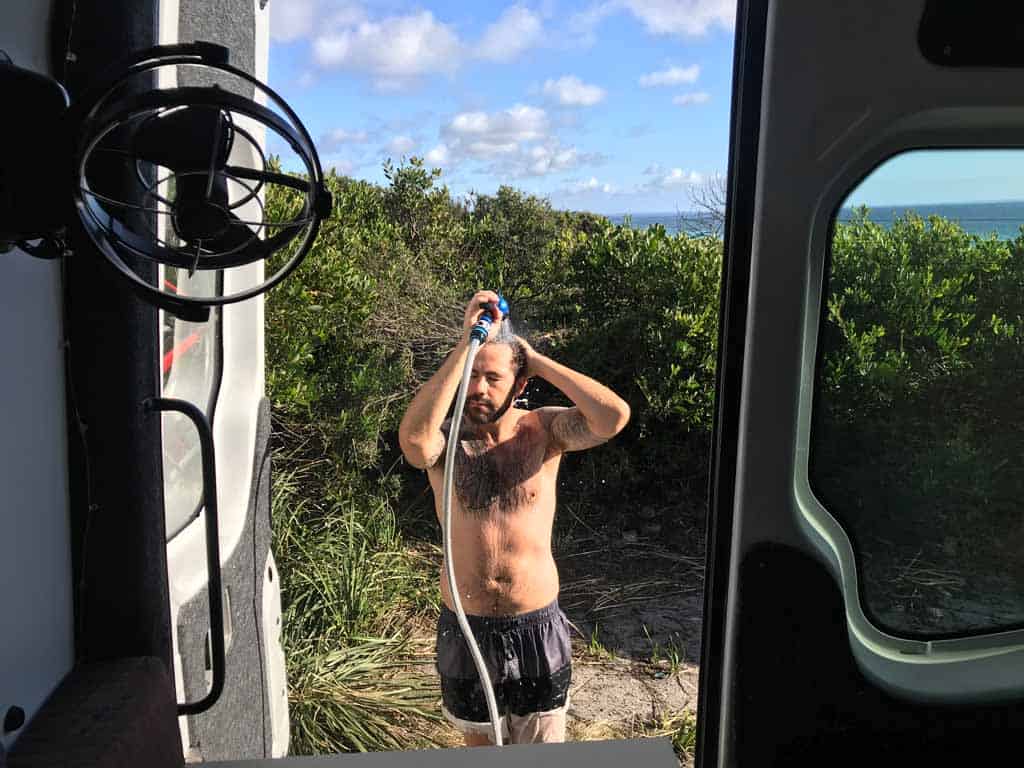
Related: Learn about the different shower options you have for van life!
Water Heater (on demand)
A hot water heater will ensure that you have a constant supply of hot water, whenever you need it. This can be for your shower, your sink, or even your tea and coffee.
A tankless water heater is a great option as it is compact and doesn’t take up a lot of space – the Mr Heater Boss is a great portable water heater option. Alternatively, the Ecotemp is by far a superior option for a fixed unit.
For an option that requires a tank, the Atwood is a great heater to opt for.
Pros
- Instant heated water on demand
- No need to keep water hot all-day
- You can take a long, hot shower
Cons
- Can be expensive
- Additional space required
- Propane heaters are a potential fire hazard
- Additional plumbing required
Water heaters require a water supply from your freshwater tanks and an appliance to provide hot water to as well as a propane supply. Other than that, they don’t require their own drainage and each individual appliance will have one.
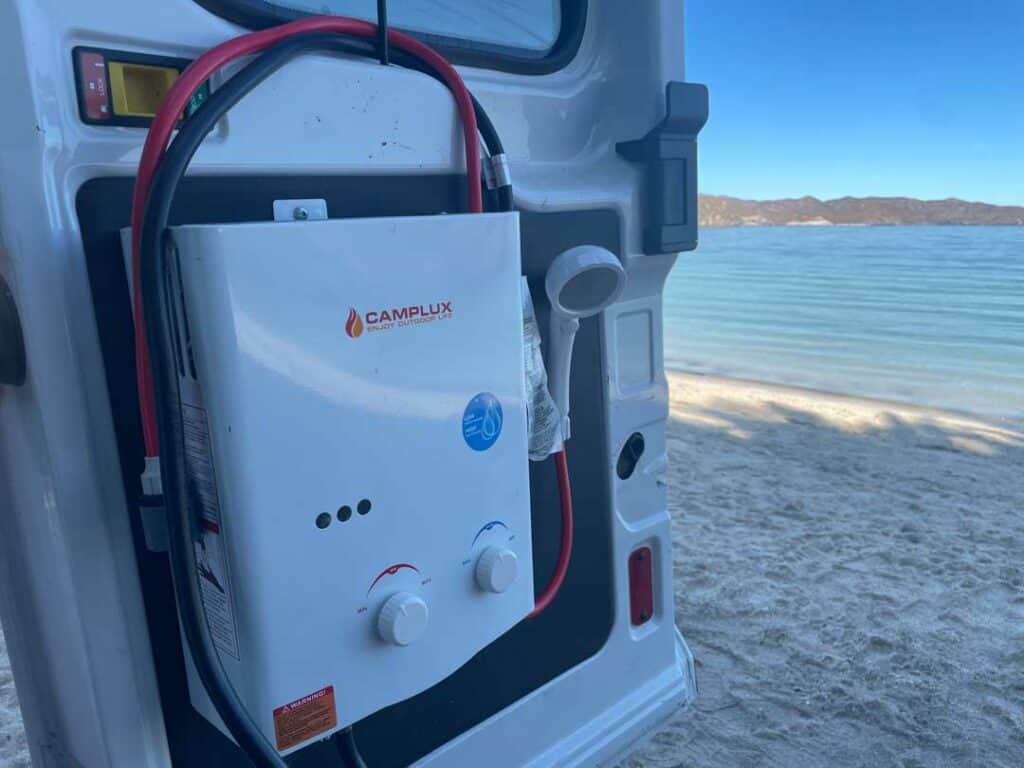
Read Next: Be sure to read through our post on the best water heaters for campervans.
This post may contain affiliate links. That means if you make a purchase a product we recommend using the links in this article, we may receive a small commission at no extra cost to you. We promise to use this pocket money to buy lots of coffee and fuel for the campervan to keep us enjoying #VanLife for just a little longer. We appreciate your support, and only recommend products we know and trust. Thank you friends!

